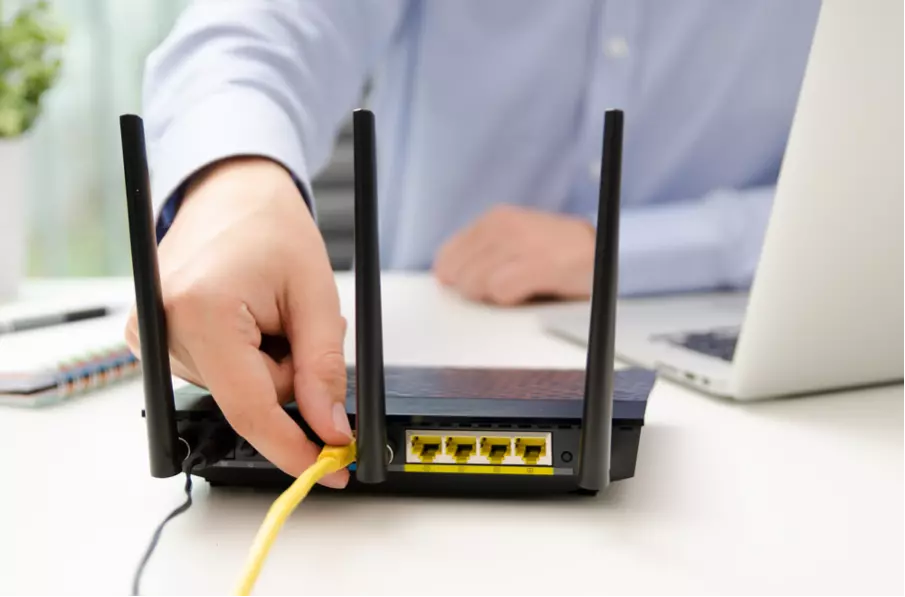The Future of Fiber: Building Homes with Better Internet
These days, we do everything from pay bills to take classes online — so it’s no exaggeration to say that every 21st-century home needs high-speed internet. That’s why fiber-optic internet connectivity, with its unparalleled speed and reliability, is quickly changing from a luxury into a must-have.
Want a faster, more reliable, and more secure connection that also helps future-proof your home for the next wave of digital demands? Consider pre-wiring your new home with fiber-friendly infrastructure, or incorporating it into your renovation project. Let’s look at why fiber optic access matters and learn some of the best strategies for creating a fiber-ready home.

Source: Hodoimg/Shutterstock.com
Why Fiber Connectivity Matters for Modern Homes
Why is fiber such an important feature for 21st-century homes? These are some of the major factors you should know about:
1. Speed and Bandwidth
Fiber connectivity provides the best possible backbone for your modern digital home, offering speeds that far surpass traditional broadband. However, the fiber difference isn’t just about faster browsing; it also helps ensure that your home can handle multiple high-bandwidth applications simultaneously.
From 4K streaming to remote work to competitive gaming, fiber’s capabilities ensure that your home network can support all your digital activities without lag or interruption. Two especially important factors are the excellent upload speeds and low latency of fiber, which allow your devices to send data out just as quickly as they take it in.
2. Reliability and Security
Fiber internet service is also known for its exceptional reliability compared to copper lines, which are more susceptible to weather and interference. The robust nature of a fiber connection makes it especially important in areas prone to severe weather, where it can provide the reliable connectivity you need.
A fiber connection also doesn’t slow down during peak demand hours like cable connections do. Furthermore, fiber is more secure than any type of copper-based internet, since its transmission technology is impossible to intercept through cable splicing and other common hacks.
3. Home Value
Finally, a fiber connection is a desirable amenity for today’s home buyers. Reliable high-speed internet is a baseline must-have, but fiber puts you significantly above the competition. Some studies have even shown that a fiber connection can potentially increase your home value.
Whether or not a fiber connection delivers a bottom-line boost to your sale price, it certainly helps market your property as a cutting-edge, future-ready home. A fiber connection is often perceived as a premium upgrade, much like high-end appliances or eco-friendly building materials, which can help your property stand out from the crowd.
Building a Fiber-Friendly Home
So, how can you make your home as fiber-friendly as possible? These are some of the key factors to keep in mind as you plan your new home or renovation project:
1. Install plenty of conduit.
Make sure to install enough conduit to route high-speed cables wherever you need them in your home. Place these conduits strategically to reach all of your key spots like living rooms, offices, and entertainment areas. Choose durable conduit materials like PVC or metal, and make sure your conduit is at least ¾” wide (preferably 1” or more). Ensure proper installation by securing conduits firmly to walls and ceilings, and keep bend radiuses relatively wide and gentle.

Source: Proxima Studio/Shutterstock.com
2. Consider running Ethernet rather than fiber itself inside your home.
A fiber network interface device (NID) provided by your fiber service provider handles the actual connection to an external fiber network. But what about the cable that carries data from devices in your home to the NID? You can use either fiber cable or Ethernet cable, but actual fiber can be challenging to work with inside a home, since it’s more fragile than traditional Ethernet. Instead, try running high-capacity Ethernet cables from your devices to the NID. These cables are robust, easier to handle, and offer power-over-ethernet (PoE) capacity that lets you power connected devices with just an Ethernet cable.
3. Use CAT6 or CAT8 ethernet cables.
Opt for high-capacity CAT6 (or CAT6A) Ethernet cables when setting up your home’s internal Ethernet networks. These cables support speeds up to 10 Gbps, which is ideal for leveraging the high-speed capabilities of fiber internet. Make sure to measure the lengths of your connections accurately to avoid excess cable, which can degrade signal quality. If you want true future-proof performance, CAT8 cables are rated for up to 40 Gbps, although they’re significantly more expensive and can be more challenging to work with.
4. Install a structured networking panel to keep cables and terminals organized.
A structured networking panel is a desirable digital amenity for any home. These panels serve as central hubs where all network connections converge, including Ethernet, coaxial, phone, and fiber optic cables. An SNP simplifies the management of your home's entire network system, allowing for easy upgrades, troubleshooting, and maintenance. For optimal accessibility and functionality, install the SNP in a centralized location such as a utility room, basement, or garage where it is easily accessible yet out of the way of daily activities.
5. Consult an expert.
A home networking expert’s advice is worth its weight in gold when you’re considering future-proof internet wiring solutions. These professionals can provide tailored recommendations for cable and equipment placement based on the specific needs and layout of your home. To find a qualified professional, search online directories, check reviews on platforms like Yelp or Angie’s List, or ask for recommendations from your internet service provider.
Fiber internet is already one of the most impactful investments you can make for your home, and it will only become more useful as the digital demands of the average household increase. By prioritizing this future-proof investment now, you’ll help ensure your home network can keep up as technology advances.
More to Read:
Previous Posts:




